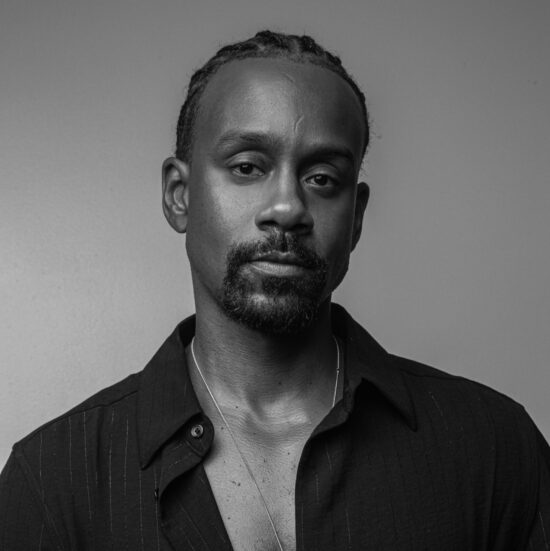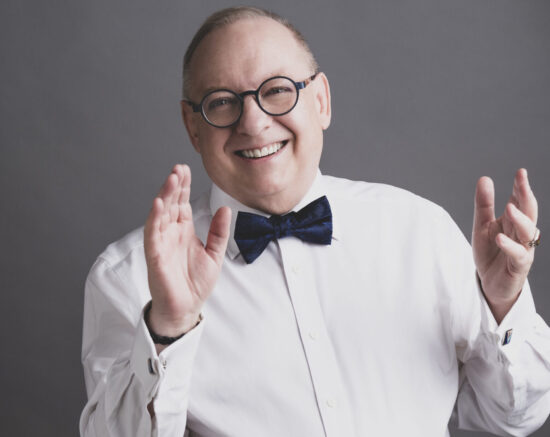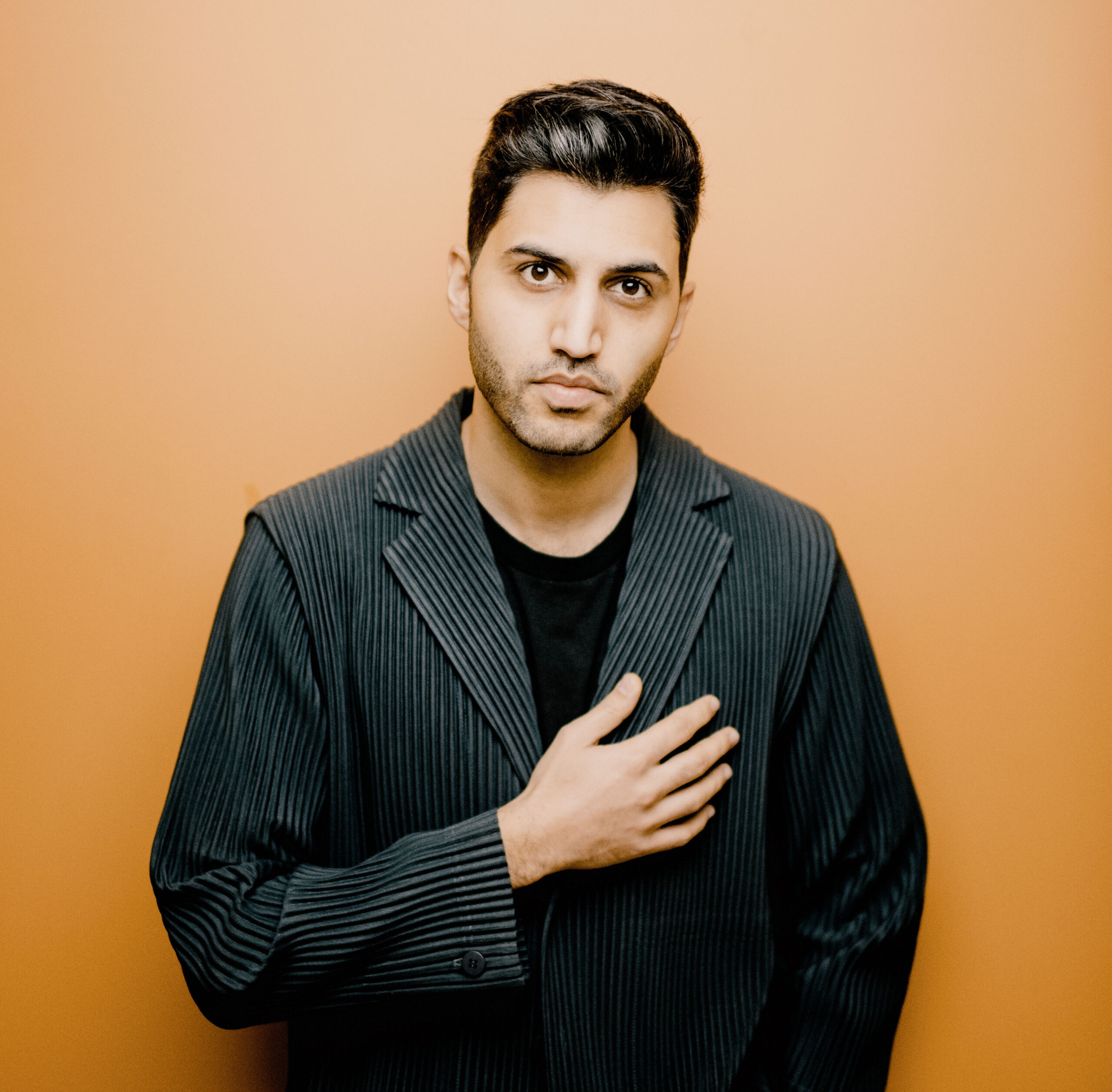Ginastera & Dvořák (October 4 & 6, 2024)
Program
October 4 & 6, 2024
Cristian Măcelaru, conductor
Antonín Dvořák (1841–1904)
- Carnival Overture, Op. 92
Gabriela Lena Frank (b. 1972)
- Concertino Cusqueño
Alberto Ginastera (1916–1983)
- Variaciones concertantes, Op. 23
- Theme for cello and harp –
Interlude for strings –
Playful variation for flute –
Variation in the style of a scherzo for clarinet –
Dramatic variation for viola –
Variation in canon for oboe and bassoon –
Rhythmic variation for trumpet and trombone –
Perpetual motion variation for violin –
Pastoral variation for horn –
Interlude for winds –
Reprise of the theme for double bass –
Final variation in the style of a rondo
for orchestra
- Theme for cello and harp –
Intermission
Dvořák
- Symphony No. 6 in D major, Op. 60
- Allegro non tanto
Adagio
Scherzo. Furiant (Presto)
Finale (Allegro con spirito)
- Allegro non tanto
From Argentina to Bohemia
If the spirit of this program were to be summed up in one word, it would be “energy.” From the opening notes of Antonín Dvořák’s Carnival Overture to the ecstatic conclusion of his Sixth Symphony, the music you’ll hear today is full of vitality. Even in the quieter moments there is a feeling of life-affirming joy. In the words of our conductor Cristian Măcelaru, we eradicate darkness by bringing beauty and light.
This concert is also distinctive in its celebration of the orchestra as an ensemble of virtuosos, with two “concerto” works giving the limelight to soloists from within the SLSO. Gabriela Lena Frank’s Concertino Cusqueño follows in the footsteps of a Baroque concerto grosso by featuring four of our principal string players in a “concertino” solo group. Meanwhile, Alberto Ginastera creates a kind of Argentine “Young Person’s Guide to the Orchestra” in his Variaciones concertantes. Like Benjamin Britten before him, he builds a set of colorful variations on a theme, each featuring a different section or solo instrument, before bringing everyone together in a thrilling finale.
Both Frank and Ginastera point to their Latin American heritage as influences, but each presents these traditional and folkloric inflections in a unique way. Dvořák’s music similarly reveals an affinity to the spirit of Bohemian national music within a very personal idiom. Today, Dvořák is represented by two enduringly popular works, both infused with the spirit of the dance. Carnival was conceived under the title “Life” and it paints a picture of life lived to the fullest in brilliant color. The Sixth Symphony has been described as “permeated with the pure song of the Czech countryside.” Its radiant outer movements frame a serene slow movement and an exhilarating scherzo in the form of a Czech dance.
Carnival Overture
Antonín Dvořák
Born 1841, Nelahozeves, Bohemia
Died 1904, Prague
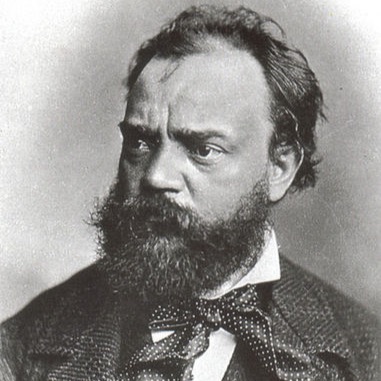
In April 1892, on the eve of his departure from Prague for the United States, Antonín Dvořák conducted the premiere of a set of three overtures. They were on the program again for his first public concert in New York—an event that drew crowds to what is now Carnegie Hall. Conceived as a trilogy under the banner “Nature, Life and Love,” today these overtures are more likely to be performed individually—In Nature’s Realm, Carnival, and Othello—and of the three Carnival is by far the most popular.
This is no surprise. Carnival isn’t just exciting to hear, it’s exciting to play, with brilliant, high-spirited music for everyone, from the piccolo at the top of the orchestra to the not-so-humble tambourine (that part, with its scintillating rolls, is a mainstay of percussion auditions). Johannes Brahms, Dvořák’s mentor and champion, was on to something when he told his publisher that music directors would be “thankful” for this irresistible overture.
It’s not all endless merriment. About three-and-a-half minutes in, a sustained horn note leads to a magical shift of mood. Listen for the English horn, flute, and oboe as they set the scene for a limpid clarinet solo, poised above shimmering, muted violins. But this is more than a beautiful moment—the clarinet’s theme is Dvořák’s Nature motto, an idea that unifies the trilogy of overtures when they’re performed together.
The carnival in question is Mardi Gras—one last mad fling before the austerity of Lent. And as Dvořák’s first biographer, Otakar Šourek, described it, this is music of the human soul “seized into the joyous vortex of life.” The technically minded may choose to hear this overture as a classical sonata-form movement with a poetic digression in lieu of the traditional development section, but the visceral appeal of Carnivallies in the mercurial emotions, dancing rhythms, and dazzling orchestral colors of this larger-than-life miniature.
Yvonne Frindle © 2024
| First performance | April 28, 1892, the composer conducting the augmented orchestra of the National Theatre in Prague |
| First SLSO performance | November 24, 1911, conducted by Max Zach |
| Most recent SLSO performance | March 12, 2014, conducted by Jacomo Bairos |
| Instrumentation | 2 flutes, piccolo, 2 oboes, English horn, 2 clarinets, 2 bassoons, 4 horns, 2 trumpets, 3 trombones, tuba, timpani, percussion, harp, strings |
| Approximate duration | 9 minutes |
Concertino Cusqueño
Gabriela Lena Frank
Born 1972, Berkeley, California
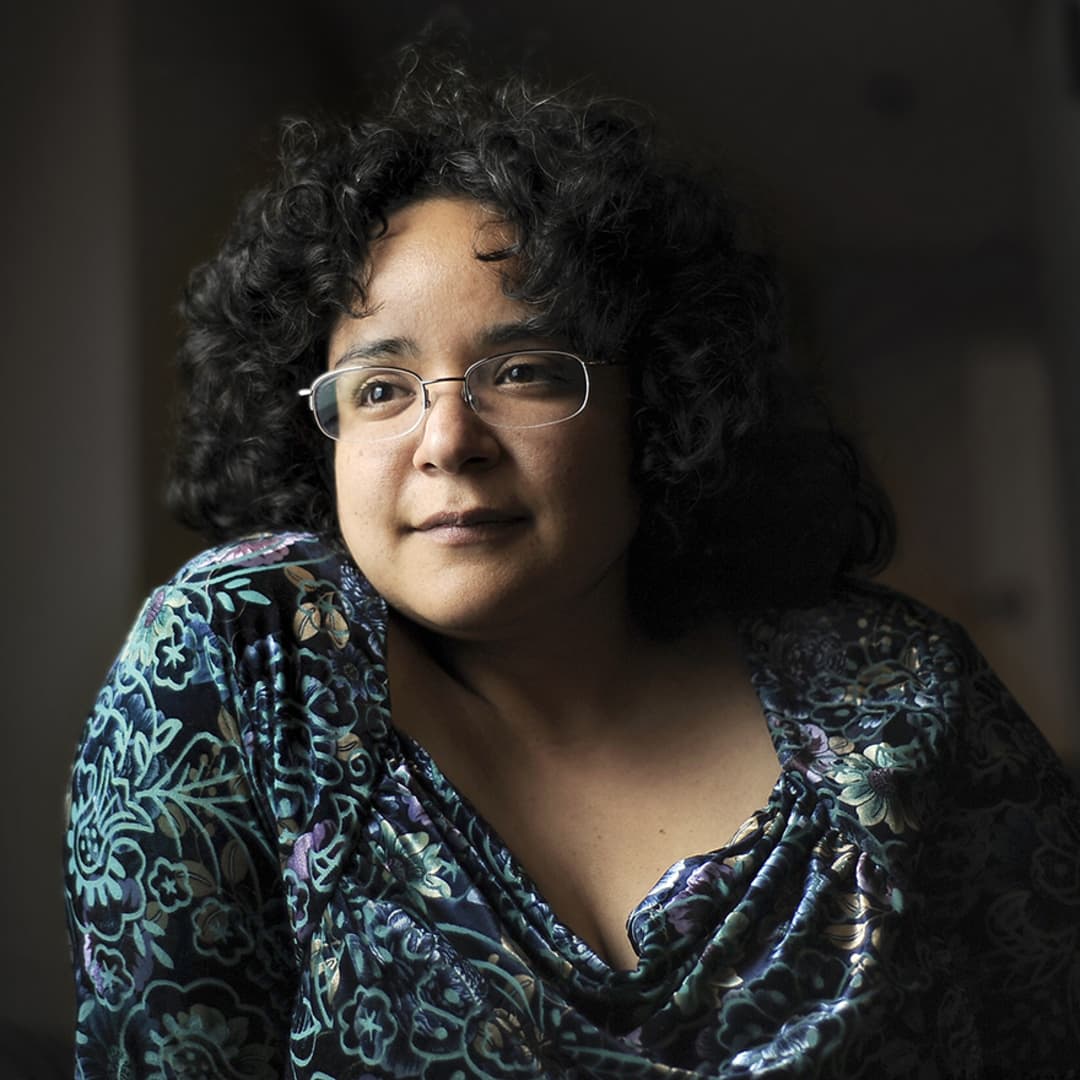
California-based composer Gabriela Lena Frank has fostered a career-long desire to explore and merge different musical cultures, even if they seem completely incompatible on the surface. This voracious creativity is reflected in her large output, which includes orchestral works, chamber music, choral pieces, and an opera.
Frank’s Concertino Cusqueño—written in 2012 for the Philadelphia Orchestra—is no exception to her artistic impulses. The work is grounded in two sources of inspiration: sounds from Frank’s Peruvian heritage and the works of 20th-century British composer Benjamin Britten, whom Frank admires “inordinately.” Frank wishes she could have met Britten and invited him to travel to beautiful Peru: “I would have shared chicha morada (purple corn drink) with him, taken him to a zampoña (panpipe) instrument-making shop, set him loose in a mercado (market)…” And she’s sure Britten would have been fascinated by the rich mythology that energizes the literature and music of this small Andean nation.
These two influences can be heard at the start. A languid yet piquant duet between piccolo and bass clarinet evokes the sacred “Ccollanan María” chant from Cusco, which is punctuated by a hint of the opening timpani gesture from Britten’s Violin Concerto. After some dramatic string chords, the four principal players from the violin, viola, and cello sections step into the spotlight, acting as tour guides for our whirlwind trip to Peru. (This is also where the first word of the title comes into play, a “concertino” referring to both a short concerto and the soloist group of a Baroque concerto grosso.)
Before long, the music quickens as we are whisked into the hustle and bustle of the mercado. Brief melodies bounce across the orchestra, vying for our attention like vendors hawking their wares. Musically, the material sounds largely “traditional” in the Western classical sense, but with a Peruvian twist, as if Britten were frantically trying to capture and sort out these new sounds on paper. The ensemble soon winds down, exhausted from the excursion to the marketplace, which heralds a return of the opening piccolo and bass clarinet duet. The work closes with an air of quiet mystery, with a wisp of Shostakovich—a composer whom Britten in turn greatly admired—heard in the celesta’s final question.
Kevin McBrien © 2024
| First performance | October 25, 2012, Yannick Nézet-Séguin conducting the Philadelphia Orchestra |
| First SLSO performance | These concerts |
| Instrumentation | 1st and 2nd violin, viola and cello principals; 2 flutes (one doubling piccolo), 2 oboes, 2 clarinets (one doubling bass clarinet), 2 bassoons, 2 horns, 2 trumpets, timpani, percussion, harp, celesta, strings |
| Approximate duration | 8 minutes |
Variaciones concertantes
Alberto Ginastera
Born 1916, Buenos Aires, Argentina
Died 1983, Geneva, Switzerland
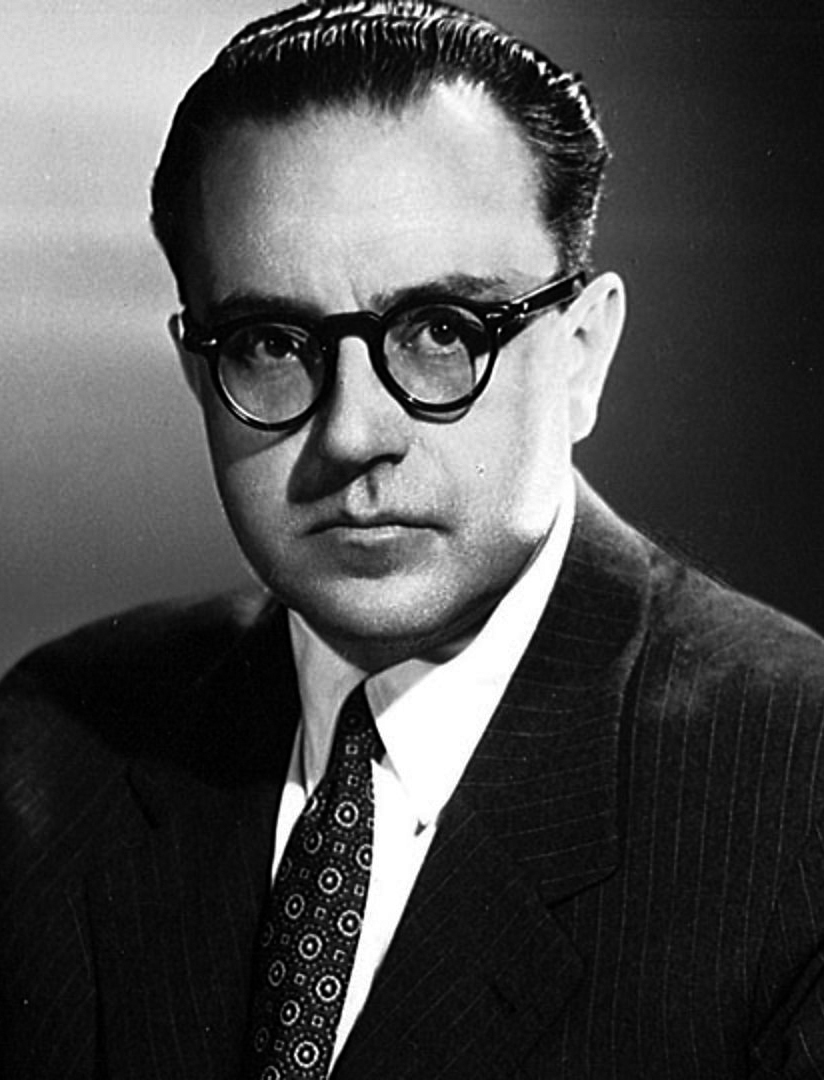
Alberto Ginastera, the most important musician of international standing yet to emerge from Argentina, consciously infused his scores with the melodic and rhythmic inflections of his homeland’s indigenous music. His early works quoted Argentine folk melodies and native dance rhythms. Later, he abandoned such overt nationalist references, allying himself with the mid-20th century avant-garde.
But even as he experimented with advanced compositional techniques during the late 1950s and ’60s, Ginastera did not lose touch with the folkloric roots of his art. As he himself noted, even his most abstract music “uses rhythmic and melodic motifs whose expressive tension has a pronounced Argentine accent.” Composed in 1953, his Variaciones concertantes is something of a transitional work. It entails neither outright quotation of Argentine folk melodies (though “a pronounced Argentine accent” certainly characterizes many passages), nor a determined use of advanced musical idioms.
In this piece, Ginastera uses the classical theme-with-variations procedure to feature different instruments with each succeeding transformation of his musical subject. And he employs not only the traditional decorative type of variation but also the more modern technique of developing entirely new material from elements of the original musical idea.
The principal theme of the work is presented by solo cello with strummed harp accompaniment. (It’s no accident that the harp’s first notes—E, A, D, G, B, E—are the same as the open strings of a guitar.) The melody is original—not derived from a folk tune—and it unfolds in a clear three-part form, with subdued music flanking a more impassioned central section. A series of short variations follow, their colors and moods captured in their titles: the flute and clarinet are given playful variations; a solo viola features in a darker and more dramatic variation; oboe and bassoon are paired for a mournful canon (the bassoon imitates the oboe’s tune at a short delay, as if they are singing a round); trumpet and trombone follow with a tiny but emphatic variation (barely 30 seconds long) that leads into a virtuoso perpetual motion variation featuring the concertmaster; and calm is restored with a gorgeous variation for the horn. These variations are framed by an interlude for the strings and another for the winds (woodwinds and brass). The harp-as-guitar returns to accompany the double bass in the original theme, before the full ensemble launches into the rondo-form finale, in which a new version of the theme recurs several times between far-ranging and brilliantly scored episodes.
Adapted from a note by Paul Schiavo © 2014
| First performance | June 2, 1953, in Buenos Aires, Igor Markevitch conducting |
| First SLSO performance | October 19, 1956, Harry Farbman conducting |
| Most recent SLSO performance | April 19, 2021, Leonard Slatkin conducting |
| Instrumentation | 2 flutes (one doubling piccolo), oboe, 2 clarinets, bassoons, 2 horns, trumpet, trombone, timpani, percussion, harp, strings |
| Approximate duration | 24 minutes |
Symphony No. 6
Dvořák
In the late 1870s, the exceptional success of his first set of Slavonic Dances, coupled with endorsements from the influential composer Johannes Brahms, brought Antonín Dvořák to the attention of a number of prominent musicians. Among these was the conductor Hans Richter, who in 1879 extracted from Dvořák a promise to write a symphony for the Vienna Philharmonic. A year later, Dvořák took the new work to Vienna to play it at the piano for Richter, who expressed his delight by interrupting the composer with exclamations and embraces after each movement. Despite his enthusiasm, Richter could not overcome strong anti-Czech feelings within the Vienna Philharmonic, which balked at presenting the new work. Dvořák, learning of this situation, decided not to wait on Vienna and offered the symphony to Prague, where it was performed in March 1881. He nevertheless dedicated the work to Richter, who conducted it in London the following year and remained a devoted champion of Dvořák’s music.
The symphony opens with one of Dvořák’s favorite mannerisms: a pair of hesitant “false starts” preceding the first full phrase of melody, as if the theme is summoning the energy to announce itself. (This is a common feature of Czech folk music, the abundant source of so much of Dvořák’s compositional style.) Once launched, this initial subject quickly traverses a wide range of moods, beginning in a leisurely and expansive manner, then passing through some measures of energetic counterpoint to a full-throated restatement that Dvořák, in the score, marks “grandioso.” A lengthy transition passage leads to a second subject comprised of a broad melody presented by the cellos and an attractive tune introduced by the oboe. Having established an ample supply of thematic material to work with, Dvořák employs all of it in the remainder of the movement.
Dvořák’s biographers and other commentators are practically unanimous in noting a resemblance between the opening of this symphony’s slow movement (Adagio) and the corresponding page of Beethoven’s Symphony No. 9. Both passages feature brief phrases built from overlapping woodwind statements serving to introduce their principal themes, given out by the strings. The contour of Dvořák’s melody, however, is not that of Beethoven’s theme, and he employs it in a personal way to fashion music that is characteristic of his most romantic manner. The Scherzo movement adopts the juxtaposed rhythmic phrases of two and three beats characteristic of the furiant, a Czech folk dance. Its great energy is also typical of the furiant. Dvořák’s bucolic Trio section, the traditional contrasting central episode, offers a well-considered change of pace.
Dvořák builds the Finale largely on a melody that has about it a wonderful sense of flowing motion, one that permeates the entire movement. It would be difficult to define the strength of this music better than the eminent English commentator Donald Francis Tovey, who wrote: “[It] is admirably endowed with that quality that is rarest of all in post-Classical finales, the power of movement…. Dvořák had the Classical secret of movement, which is not a power that can be obtained at the expense of higher qualities, for it is one of the highest.” The first audience in Prague expressed the same enthusiasm in fewer words: calling for an immediate encore.
Adapted from a program note by Paul Schiavo © 2007
| First performance | March 25, 1881, Adolf Čech conducting the Czech Philharmonic Orchestra in Prague |
| First SLSO performance | January 28, 1971, conducted by Walter Susskind |
| Most recent SLSO performance | January 6, 2007, conducted by Hans Graf |
| Instrumentation | 2 flutes (one doubling piccolo), 2 oboes, 2 clarinets, 2 bassoons, 4 horns, 2 trumpets, 3 trombones, tuba, timpani, strings |
| Approximate duration | 41 minutes |
Artists
Cristian Măcelaru

Romanian-born Cristian Măcelaru is Music Director of the Cincinnati Symphony Orchestra and will conduct his inaugural season in this role in 2025/26. He is also Artistic Director of the George Enescu Festival and Competition, Music Director of the Orchestre National de France, Artistic Director and Principal Conductor of the Interlochen Center for the Arts’ World Youth Symphony Orchestra, Music Director and Conductor of the Cabrillo Festival of Contemporary Music, and is serving his final season as Chief Conductor of the WDR Sinfonieorchester in Cologne, Germany.
His musical education began with violin, and his studies brought him to the U.S. where he attended the Interlochen Arts Academy, University of Miami, Rice University (studying conducting with Larry Rachleff), Tanglewood Music Center, and Aspen Music Festival. He was the youngest concertmaster in the history of the Miami Symphony Orchestra, making his Carnegie Hall debut with them at the age of 19.
As a conductor, he first came to international attention in 2012, deputizing for Pierre Boulez with the Chicago Symphony Orchestra. He also received the Solti Emerging Conductor Award, followed in 2014 by the Solti Conducting Award. Since then, he has regularly conducted the best American orchestras, including the Chicago Symphony Orchestra, New York Philharmonic, Los Angeles Philharmonic, Cleveland Orchestra, Philadelphia Orchestra, and National Symphony Orchestra, as well as the SLSO, where he is returning for the sixth time. He made his Carnegie Hall conducting debut in 2015 in a program with the Danish National Symphony Orchestra and violinist Anne-Sophie Mutter. A keen opera conductor, he has conducted productions for Houston Grand Opera, Tanglewood Contemporary Music Festival, and Cincinnati Opera.
Cristian Măcelaru is also in demand as a guest conductor in Europe and the U.K., and highlights of the 2023/24 season included tours to China with the WDR Sinfonieorchester, and to Austria and Spain with the Orchestre National de France. He also made debut appearances with the Philharmonia and London Philharmonic orchestras, and returned as a guest to the NDR Elbphilharmonie and Swedish Radio Symphony orchestras.
Program Notes are sponsored by Washington University Physicians.
